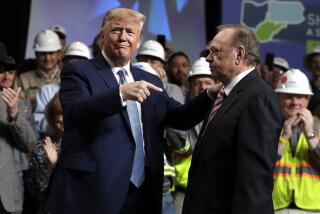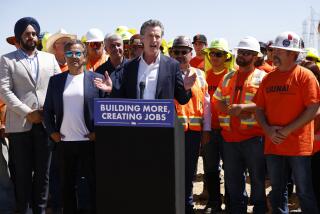Column: With Trump’s election, is stimulus spending back on Washington’s agenda?
Has John Maynard Keynes just won a ticket back to the White House?
Keynes was the British economist who advocated government deficit spending to stimulate moribund economies. And that seems to be the principle undergirding the $1-trillion infrastructure construction plan that President-elect Donald Trump proposed shortly before election day. Trump outflanked a $275-billion plan offered by his Democratic opponent, Hillary Clinton — though he asserted that his plan would require only $167 billion in actual government outlays via tax credits to private construction companies.
The program was a linchpin of Trump’s promise to pump up U.S. economic growth to 4% a year and create 25 million new jobs. He gave it prominence in his victory speech early Wednesday morning: “We are going to fix our inner cities and rebuild our highways, bridges, tunnels, airports, schools, hospitals,” he said. “We are going to rebuild our infrastructure, which will become, by the way, second to none. We will put millions of our people to work as we rebuild it.”
Many economists doubt that Trump’s plan would put infrastructure construction where it’s most needed, or that the program is affordable. But the prospect of a surge in government spending may have helped buoy the U.S. stock market in the early days after his election.
Among the big winners were steel stocks such as U.S. Steel, which would probably benefit from a construction program aimed at roads, bridges and airports. U.S. Steel already had nearly tripled in price since the beginning of the year and surged more than 17% in New York Stock Exchange trading Wednesday.
All we have gotten from tilting at Keynesian windmills is a doubling of our national debt from $10 trillion to $20 trillion.
— Peter Navarro and Wilbur Ross, “Scoring the Trump Economic Plan”
The British economist Keynes originated his best-known theories in the years between the world wars. His argument that government should borrow to stimulate the economy when private investment goes into hiding has guided economic stimulus programs ever since, including President Obama’s $831-billion stimulus program in 2009. Although Keynes wasn’t well-known in the U.S. during the 1930s, the same principle animated the New Deal, which sponsored the greatest surge of public construction before or since to fight the Depression.
Yet Keynes’ memory is often cursed by conservative economists, who fret that deficit spending will depress economic growth by driving up interest rates. Indeed, the architects of Trump’s infrastructure plan, UC Irvine economist Peter Navarro and private equity investor Wilbur Ross, took a swipe at Keynes in their paper outlining the program in September, though their complaint was chiefly that government spending after the 2008 crash had been squandered.
“All we have gotten from tilting at Keynesian windmills,” they wrote, “is a doubling of our national debt from $10 trillion to $20 trillion under Obama-Clinton and the weakest economic recovery since World War II – combined with depleted infrastructure and a shrunken military.”
Some investors and economists reckon that Trump might have a better chance of enacting a spending program than Clinton would have, since as a Republican president he will be working with a GOP majority in both houses of Congress; pushback from deficit-wary congressional Republicans stunted the Obama stimulus program in 2009.
But that’s not a universally held view. “Corporate tax reform and increased spending on infrastructure appear to have limited bipartisan support,” observed strategists at the investment firm BlackRock, who called such plans “a ripe area for negotiation” between the Trump White House and Capitol Hill.
More serious doubts involve whether the program would be “revenue neutral,” as Navarro and Ross contend. According to their proposal, private companies willing to build infrastructure projects would put up their own money but receive a tax credit equal to 82% of their equity investment. That would reduce their financing costs by as much as 20%, Navarro and Ross calculate.
They say the tax credits would pay for themselves through higher taxes paid by workers hired to build the projects and from taxes on the building companies’ profits. They add that historically low interest rates on government debt offer “a unique opportunity” to reverse decades of under-investment in “our complex network of airports, bridges, highways, ports, tunnels, and waterways.”
There are a few problems with this scenario, however. One is the introduction of the profit motive in determining which projects are undertaken by private builders. Typically, public works are launched by government precisely because they’re perceived to offer a public benefit, but no discernible profit opportunity for private enterprise.
For example, utilities companies saw a chance for profits from harnessing the Colorado River for hydro power, and Southern California growers saw a financial rationale for a flood-control and irrigation source on the river, but no one could justify making the investment to do all three with one project — until the government stepped in and built Hoover Dam.
By the same token, the Pentagon saw the value in creating a data network to allow its disparate computer contractors to communicate with one another; but AT&T, the private monopoly controlling the nation’s phone network, saw no gain from data transmission and feared it would interfere with its cash cow, voice calls. So the government built the ARPAnet, which evolved into the Internet. Both these projects have, in time, created billions, even trillions, of dollars in profits for private companies that cashed in on the original public investment.
Navarro and Ross argue that their tax subsidy will make private builders more willing to undertake projects with more dubious financial returns, but it certainly doesn’t go far enough. Consequently, projects will be concentrated in markets where there’s already demand, as well as the presence of users willing to pay directly for the benefit. But little is in the way of private investors building such projects now.
Navarro and Ross imply that their plan would alleviate infrastructure disasters like the Flint, Mich., water system, but that’s dubious. As a low-income community needing a functioning water utility, Flint displays the kind of infrastructure need that can’t be financed by users, at least on terms that would attract private investors even with a subsidy. It’s the kind of project that demands a public solution, period.
Furthermore, Navarro and Ross misdiagnose the malady affecting our infrastructure investment. They blame, among other things, regulatory obstacles — “endless studies, government reviews, and litigation” for interfering with the free flow of financing. This is conventional conservative regulation bashing, but it fails to acknowledge that major construction projects can have impacts on many communities and raise issues needing to be addressed at a political level, not merely as an exercise in profit-and-loss math.
Take the Keystone pipeline, which was blocked by the Obama White House even though, they say, it “would have amounted to an $8 billion investment in U.S. infrastructure and create 42,000 jobs.”
But this investment imposed costs demanding to be weighed — the potential for environmental damage and the downside of encouraging more fossil fuel development when the world is moving more toward renewable energy. Navarro, Ross and Trump may have disagreed with how the balance was struck, but they can’t rule the balancing test itself out of order, even if it means that some private companies will be deprived of a profitable investment.
The Trump plan views infrastructure building as purely a financing problem. It’s not certain that he solves even that much. But it is clear that the plan ensures that projects will be built largely to address affluent markets, or those that can be mulcted for user fees, rather than those that need help the most.
Navarro and Ross acknowledge that America is in dire need of infrastructure investment and — their swipe at Keynes notwithstanding — that it’s a driver of economic growth. But they don’t explain why instead of relying on an elaborate financing scheme, the government shouldn’t just borrow the money, hire construction contractors to do the work and build, build, build.
Keep up to date with Michael Hiltzik. Follow @hiltzikm on Twitter, see his Facebook page, or email [email protected].
Return to Michael Hiltzik’s blog.
More to Read
Get the L.A. Times Politics newsletter
Deeply reported insights into legislation, politics and policy from Sacramento, Washington and beyond. In your inbox three times per week.
You may occasionally receive promotional content from the Los Angeles Times.











